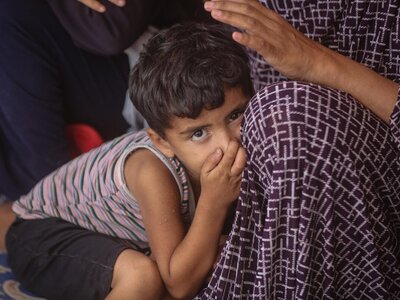Emergency
State of Palestine
- 1.6 million
- people facing high levels of acute food insecurity
- 100,000-plus
- children projected to face acute acute malnutrition
- US$347.5 million
- needed for WFP operations in Gaza and the West Bank up to May 2026
Intense conflict, the collapse of essential services and severe limitations on humanitarian assistance have led to desperate conditions across the Gaza Strip.
At least 1.6 million people - or 77 per cent of the population - are facing high levels of acute food insecurity, according to the latest Integrated Food Security Phase Classification (IPC).
This includes over 100,000 children and 37,000 pregnant and breastfeeding women projected to suffer acute malnutrition through to April 2026.
Four governorates (North Gaza, Gaza Governorate, Deir al-Balah and Khan Younis) have Emergency levels of hunger (IPC Phase 4).
A ceasefire paves the way for humanitarian agencies to reach vulnerable populations previously cut off from life-saving aid.
The World Food Programme (WFP) aims to feed up to 1.6 million people in the coming months.
To deliver at scale, we require fast, efficient use of all entry points, secure and unhindered humanitarian access, rehabilitation of vital infrastructure and storage facilities, and faster clearance protocols.
We call on all parties and the international community to ensure the instant, safe delivery of life-saving food.
What the World Food Programme is doing to respond to the Palestinian emergency
-
Food and cash assistance
-
WFP plans to feed up to 1.6 million people – around 320,000 families – between October and January 2026, with bread, wheat flour and family food parcels. We will increase the number of bakeries we support from 10 to 30 in the coming weeks, dramatically increasing access to fresh bread. Additionally, WFP will expand its nutritional support for pregnant and breastfeeding women, which the agency has already been increasing over the past few weeks. Digital payments are being made to the most food-insecure people. Around 140,000 people have already benefited from these payments, which allow for the purchase of food in local markets. WFP plans to double the programme in the coming weeks.
-
Logistics
-
Recovery

